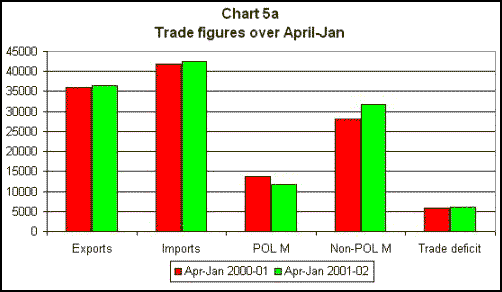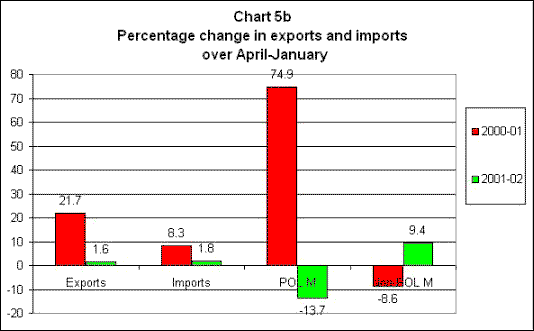The
problems on the external trade front have clearly
carried over into the recent past. Charts 5a and 5b
show that very recent trends in export and import
continue to be disturbing. Despite a dramatic fall
in oil prices over the past year, imports have increased,
mainly due to a significant increase in non-oil imports
despite the continuing domestic recession. Meanwhile
export growth has slumped, from more than 20 per cent
in 2000-01, to just above 1.5 per cent in the past
year.

Chart
5a >> Click
to Enlarge

Chart
5b >> Click
to Enlarge
In
fact, the most recent data released by the DGCI&S
reveal an even more bleak pattern. Aggregate exports
in the period April 2001 to February 2002 barely increased
at all, registering a pitiful 0.06 per cent rise over
the corresponding period of the previous year. Since
March is notoriously a bad month for exports, this
suggests that exports in dollar terms are likely to
have been stagnant over the past fiscal year.
This cannot be seen as a reflection of the poor growth
of world markets. It is true that total world merchandise
trade slowed down dramatically in 2001, growing at
only 2 per cent compared to 12 per cent in 2000. But
Indian export growth has been even lower than this
- in fact 33 times lower !
Meanwhile, imports
have continued to grow – in value terms by 2.3 per
cent and by much more in volume terms. Since low world
oil prices prevailed over much of the year, this reflects
that non-oil imports grew by nearly 9 per cent in
value terms, and even more in volume terms, over this
period. This obviously means that import penetration
continues to affect domestic producers adversely.
Features of the Exim Policy
In
this context, it is quite understandable that the
Commerce Minister decided to make export growth one
focus of the new medium term Exim Policy, which was
announced on 31 March. There is no doubt that a successful
export thrust in the future will have to be associated
with a systematic policy, since it is now clear that
relying only on private market-determined responses
is inadequate for the purpose.
The objectives of the Exim Policy 2002-07 are clearly
ambitious. It explicitly aims to facilitate export
expansion such that India's share of world exports
reaches at least 1 per cent of world trade by the
end of the period. In addition to this it proposes
to stimulate sustained economic growth by providing
access to essential raw materials, intermediates,
components, consumables and capital goods requires
for augmenting production and providing services.
The Policy further plans on enhancing the technological
strength and efficiency of Indian agriculture, industry
and services, thereby improving their competitive
strength while generating new employment opportunities.
It proposes simultaneously to encourage the attainment
of internationally acceptable quality standards. All
this would then provide Indian consumers with good
quality goods and services at internationally competitive
prices.
While
this is an optimistic outline of a future paradise
for Indian producers and consumers; but the crucial
question, of course, is how to get there. The unfortunate
reality is the Commerce Minister may have missed the
basic point in terms of what determines export growth
and improved "competitiveness".
The apparent belief is that even more liberalisation
combined with some fiscal concessions will do the
trick. However, it is quite clear to most observers
– and especially to exporters themselves – that problems
of poor and costly infrastructure facilities, and
inadequate access to reasonably cheap credit are among
the most significant problems currently plaguing Indian
producers.
In
fact, the Exim Policy statement does not even mention
these issues, much less discuss ways in which such
problems could be dealt with. One of the most urgent
problems for goods exporters relates to the backlog
and slow rate of movement through India's ports, which
raises costs and affects markets for export goods.
The problems of poor transport in general and unstable
(and increasingly expensive) access to power and other
essential inputs put domestic producers at a major
disadvantage compared to their international competitors.
Another major area of concern is the difficulty faced
by small-scale exporters in raising bank credit, especially
after financial liberalisation measures have reduced
allocations for priority sector credit.

